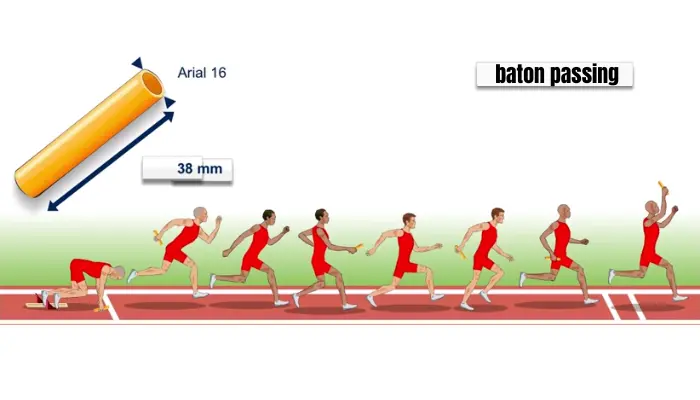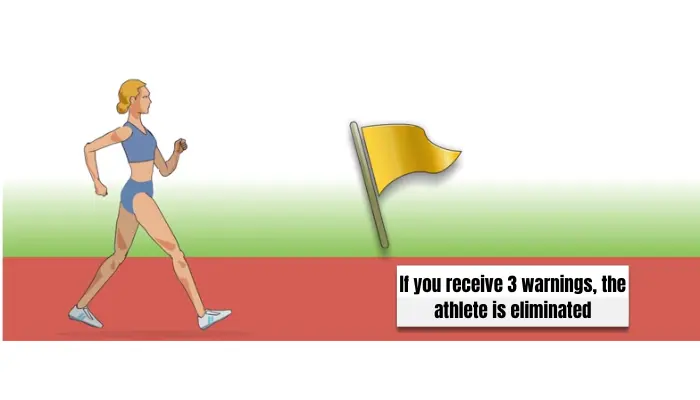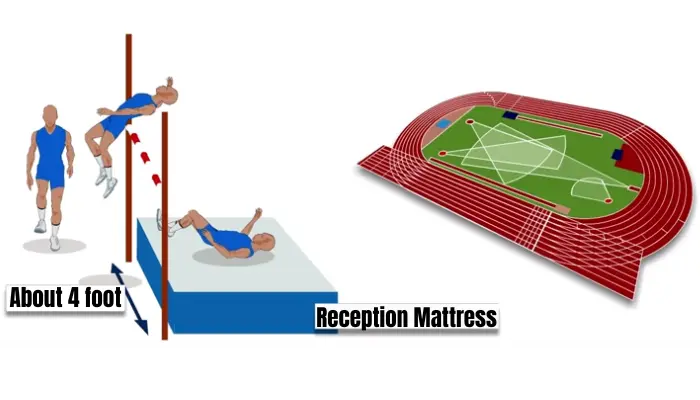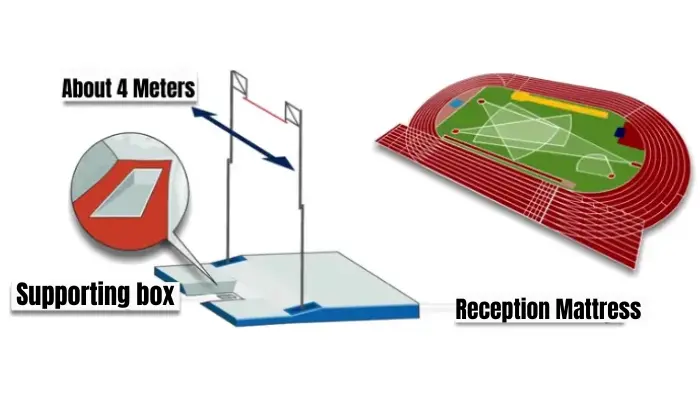The Modalities of Athletics
The Athletics Modalities in the Olympics encompass several events, for men and for women, in each of which different resources are required from the athlete, such as endurance, strength, speed, and impulsion.
The current Olympic Athletics program comprises the following sports.
Track Modalities
Track and Field is composed of races. The following disciplines are part of the track and field disciplines:
-
Individual shallow runs;
-
Running with hurdles;
-
Racing with obstacles;
-
Shallow relay races.
Individual Flat Races
Individual Flat Races are a type of athletics race played on the track without obstacles or barriers.
Types of Individual Flat Races
Individual shallow races are divided into three types:
-
Shallow short distance or speed runs;
-
Shallow mid-distance or middle-distance running;
-
Shallow long-distance or cross-country running.
Short Distance or Speed Races
The individual shallow races of short distance or speed are:
-
328 ft (foot) dash;
-
656 ft (foot) dash;
-
1.312 ft (foot) dash.
Rules Regarding Speed Races
-
The athletes start from starting blocks.
-
During shallow short-distance athletics races, athletes cannot step outside their lane or leave the starting block before the starting pistol, in which case they are eliminated.
-
In the 656 ft (foot) and 1.312 ft (foot) the starting positions are not aligned, to compensate for the curves.
Middle Distance Flat Runs
Shallow Half-Distance races are middle-distance races contested on the athletics track.
These are shallow mid-range races:
-
2.624 ft (foot) dash;
-
4.921 ft (foot).
Rules Relating to Shallow Middle-Distance Races
-
In the 2.624 ft (foot) the athletes can leave their lanes and mingle on the track after the first turn
-
In the 4,921 ft (foot) the athletes can leave their lanes and mingle on the track right after the start.
Flat Bottom Races
The shallow end races are long distance races contested on the athletics track.
These are shallow endurance races in Olympic athletics:
-
16.404 ft (foot);
-
32.808 ft (foot).
Rules Regarding Flat Bottom Races
-
In the 16,40 ft (foot) and 32,808 ft (foot) races, athletes can leave their lane and mingle on the track right after the start.
The Barrier Races
Barrier races are athletic disciplines that take place on the track, where athletes must jump several individual hurdles.
The hurdle races contested in the Olympics are:
-
Women’s 360 ft (foot) hurdles;
-
360 ft (foot) with hurdles for men;
-
1.312 ft (foot) with hurdles for men and women.
Rules Relating to Barrier Fence Racing
-
Athletes are allowed to lean against and knock down the barriers during races.
-
Athletes must stay on their lanes in the 328, 360, and 1.312 ft (foot) hurdles races.
-
They start from starting blocks, and you can’t “burn” the start.
-
The height of the hurdles in the 328 and 360 ft (foot) races is 347 ft (foot) for men and 275 ft (foot) for women
-
In the 328 and 360 ft (foot) races, the athletes must pass through 10 barriers
-
In the 1.312 ft (foot) race the hurdles are 298 ft (foot) for men and 249 ft (foot) for women
-
In the 1.312 ft (foot) race, the athletes must pass through 10 hurdles.
Obstacle Course in Athletics
The athletics obstacle course that is part of the Olympic Games is the 9.842 ft (foot) hurdles race. In this discipline, athletes must jump over trestles and water trenches.
Rules Related to Obstacle Course Racing
-
The course length for this athletics event is 9.842 ft (foot)
-
The obstacle height is 35,98 inch for men and 28,03 inch for women
-
The number of times the athletes jump over the obstacles in this race is 28 times over the trestles and 7 times over the water pit.
Racing with Relay
Relay races in athletics are disciplines disputed by teams composed of four athletes. Each athlete must run ¼ of the race.
The athletics relay race disciplines that are part of the Olympic calendar are:
-
Men’s and women’s 13×328-ft (foot) relay;
-
13x1.312 ft (foot) men and women;
-
13x1.312 ft (foot) mixed (team composed of two men and two women).
Athletics Rules for Relay Events
-
Each team must carry one stick from the beginning to the end of the race.
-
The Stick can only be passed in an area called the Transition Zone.
-
If the Stick falls or is passed outside the transition zone the team will be eliminated.

Street Athletics
The street athletics disciplines that are part of the Olympic Games are the Athletic Walking and the Marathon.
Athletic Marching
The Athletic March is one of the most curious or exotic sports in athletics because of the way the athletes run in this race.
The Athletic Walking disciplines contested in the Olympic Games are:
-
20 km male and female;
-
Men’s 50 km.
Rules Related to Athletic Walking in Athletics
-
Athletes cannot lift both feet off the ground at the same time.
-
The step should be taken first with the heel, and the supporting leg cannot be flexed.
-
There are judges who supervise the race, so that the rules are not violated.
-
If an athlete violates the rules 3 times they will be eliminated or suffer a penalty.

Marathon in Athletics
The Marathon is a street race of 26,2187 miles in distance.
During the marathon course there are markings every 1 km, so that the athletes can orient themselves at which point of the race they are.
The marathon takes place on roads with the course closed off to vehicles.
The Athlete cannot deviate from the course and there are hydration stations along the race route.
The marathon athlete may be removed from the race by medical intervention.
The marathon race is contested in both men and women.
Jumping Modalities of Athletics
These are Jump modalities in Athletics:
-
High jump;ff
-
Pole vaulting;
-
Long jump;
-
Triple jump.
High Jump
The High Jump consists of jumping a horizontal bar supported by two and placed at the highest possible height.
High Jump Rules
-
The high jump must be done without the help of any equipment.
-
The thrust must be done with the legs.
-
Touching the bar is allowed, but not knocking over the bar.
-
The bar is 1.312 ft (foot) long.
-
The athletes have 3 attempts per jump.
-
An athlete who fails to make a valid jump after 3 attempts will be eliminated from the competition.
-
Tiebreaker criteria: jumper with the fewest attempts, least foul or tiebreaker jump.

Pole Vaulting in Athletics
The sport of Pole Vaulting in Athletics consists of jumping over a horizontal bar, placed as high as possible, using a pole to get more height.
Pole Vault Rules
-
The athlete started from a 147 ft (foot) track holding the pole.
-
At the end of the track there is a support box, where the athlete must fit the pole (so as not to slip).
-
The horizontal bar is 147,638 ft (foot) long, holds up to 4,98 ib, and is supported by two poles.
-
After the bar there is a 16×16 ft (foot) short to cushion the athlete’s fall.
-
The stick has variable height, diameter, and flexibility, at the athlete’s choice.
-
The athletes have three attempts to perform a valid jump.
-
An athlete who fails to perform a valid jump in three attempts will be eliminated.
-
Dropping the bar is not allowed.
-
The tie-breaker is done by the fewest number of attempts.

Long Jump
The Long Jump consists of jumping the longest distance possible from a track and jumping over a sandbox.
Long Jump Rules
-
There is a 131 ft (foot) track where the athlete runs to perform the jump.
-
The jump must be made over a push board that is at the end of the track.
-
There is a strip on the leap board indicating the limit that the athlete must not exceed to make a valid jump.
-
The athletes have 3 to 6 attempts to make a valid jump.
-
The distance is marked at the first point of contact with the athlete in the sandbox.
-
The athlete who jumps the greatest distance wins the race.
-
In case of a tie, the jumper with the second highest jump wins the competition.
Triple Jump Modality
The Triple Jump modality consists of a combination of three successive jumps and ending with a fall into a sandbox.
Triple Jump Rules
- There is a running track that is 131 to 147 ft (foot) long.
-
At the end of this track is a thrust board.
-
On the push board there is a strip indicating the limit point where the first jump should be made.
-
The track where the jumps will take place (just after the jump board) is 36 ft (foot) long for women and 42 ft (foot) long for men.
-
Each athlete has three attempts to perform a valid jump.
-
The athlete must perform the first two jumps with the same foot and the third jump with the other foot.
-
The tie-breaker is done by the fewest number of attempts.
Throwing Sports in Athletics
These are called strength events, in which the athletes must throw or throw objects so that they reach a long distance.
See below for all the Throwing and Throwing events in Athletics.
Weight Throwing Mode
The Weight Throw consists of throwing a metal ball, as far away as possible, from a throwing area.
Weight Throwing Rules
-
The metal ball is 15,87 ib and 4,72 inch in diameter for men, and 8,81 ib and 3,54 inch in diameter for women.
- The throwing area is a circle that is 7.004 ft (foot) in diameter.
-
The athlete cannot go beyond or step on the boundaries of the throwing area.
-
The throw must be made within the demarcated area.
-
The athlete can only leave the throwing area after the metal ball touches the court.
-
The distance achieved is measured from the edge of the throwing area to the point where the metal ball hit the ground.
-
The athletes have from 3 to 6 throwing attempts.
-
The tie-breaker is made by the second highest mark achieved.
Weight Throwing Stages
-
Support the weight between your neck and shoulder and at the base of your fingers.
-
Spread your legs apart, bend your knees and support your body weight on one leg.
-
Do the displacement (without spin in initiation sports and with spin in high-performance sports).
-
Perform the throw.
-
Make the recovery to avoid leaving the throwing area.
Discus Throwing Modality
The Discus Throwing modality consists of throwing a metal disc as far as possible from a throwing area, towards the throwing area on the field.
Discus Throwing Rules
-
The discus is 4,40 ib for men and 12,20 ib for women.
-
The launch area is 8,20 ft (foot) in diameter and is surrounded by a protective cage that is 13 ft (foot) high.
-
You are not allowed to step on or over the edges of the throwing area before the disc touches the field.
-
The throw-in must be made towards the field, within the demarcated area.
-
The athletes have 3 to 6 throwing attempts.
-
The tie-breaker is made by the second best mark achieved.
Phases of Discus Throwing
-
Handle.
-
Starting position.
-
Balance.
-
Spin (advanced technique).
-
Release.
-
Reversal or recovery to avoid leaving the launch area.
Hammer Throwing Mode
Hammer Throwing in Athletics consists in throwing the hammer implement as far as possible towards the marked throwing area on the field.
Hammer Throwing Rules
-
The hammer consists of a metal ball attached to a steel cable and a handle where the athlete holds the implement.
- The assembly that forms the hammer is at most 3,93 ft (foot) long.
-
The hammer is 15,87 ib for men and 8,81 ib for women.
-
The launch area is a circle that is 7004 ft (foot) in diameter.
-
Surrounding the launching circle is a 32 ft (foot) high protective cage.
-
The athlete cannot step on the edge or over the edge of the throwing area until the hammer touches the court.
-
The athlete cannot take more than 1 minute to perform the throw.
-
The throw-in must be made within the throw-in angle demarcated on the field.
Hammer Throwing Phases
-
Starting position and grip.
-
Windlass (turning the hammer on its head).
-
Cute.
-
Release.
-
Reversal or recovery so as not to leave the throwing circle.
Modality Javelin Throwing
The javelin throw in Athletics consists of throwing the javelin implement as far as possible towards the throwing area on the field.
Javelin Throwing Rules
-
Darts are made of metal, fiberglass, or carbon fiber.
-
There are ropes wrapping the darts right at the center of gravity (where the athlete holds the dart).
-
The javelin is 8,85 ft (foot) and 800 grams for men, and 7,54 ft (foot) and 600 grams for women.
-
There is a launching track that measures 98 to 119 ft (foot) in length.
-
The athletes have 3 launching attempts.
-
Stepping on or over the throwing line disqualifies the athlete.
-
The dart should fall with its front end in the field.
-
The throw-in must be made within the area demarcated on the field.
-
The distance is measured from the boundary of the throwing area to the point where the dart strikes the field.
-
The tie-breaker is made from the second best mark.
Heptathlon in Athletics
The Heptathlon in Athletics is a two-day, women-only competition consisting of seven events.
1st Day of Heptathlon Trials
There are four races contested on the 1st day of the Heptathlon:
-
328 ft (foot) with hurdles;
-
High Jump;
-
Weight Throwing;
-
656 ft (foot) dash.
2nd Day of Heptathlon Trials
The second day of the Heptathlon features three events:
-
Long Jump;
-
Javelin Throwing;
-
2.624 ft (foot) dash.
Heptathlon Scores
Heptathlon athletes receive points for their performance in each of the events, according to a table drawn up by the International Association of Athletics Federations (IAAF).
Heptathlon Rules
The rules of the heptathlon are the same as those of the disciplines that comprise it.










